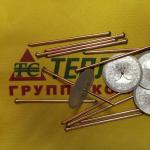
Miklashova E.V. A comparative analysis of the state and development of markets for trade in medical equipment in Russia and abroad. The volume and structure of the market. Consumption of IMN by regions and major cities
Alexey Vanin, mDPRO CEO, Andrei Estrin, medical Product Expert
The market analysis was conducted on the basis of data on public procurement medical devices, the base of export-import operations of official customs statistics, as well as open sources of information (official statistics in the field of health, publication of international marketing agencies, reports of companies, etc.)
Main trends
The total consumption of medical products in Russia in 2014 amounted to 269.4 billion rubles, which is 6% lower than 2013 level (in value terms). At the same time, the volume of government procurement decreased by almost 10%.
If the decline in consumption in 2013 was associated primarily with the saturation of the market during the implementation of regional health modernization programs in 2011--2012, the negative dynamics of 2014 is mainly due to the restriction of public health expenditures in general and redistribution. money from the purchase of medical devices in favor of medicinal support and payments wages medical workers.
And if in 2013, the redistribution of state LPU costs was observed in favor of the content of the formed equipment fleet (repair, consumables) to the detriment of the expenditure of funds for the further increase in the park itself, in 2014 this trend began to lose force, the redistribution of segments and their Displacement to natural volumes.
As a year earlier, consumables were consumable in 2014. The share of those segments increased, in the structure of consumption of which consumables and disposable medical products prevail (products for in-vitro-diagnosis, general surgery and endoscopy, cardiovascular surgery and neurosurgery, orthopedics). In turn, a decrease in shares was typical for segments, a large sales in which are accounted for for medical equipment (products for diagnostic visualization and resuscitation) ( fig. one).

The largest segments in the structure of the consumption of medical devices in 2014 were products for in-vitro-diagnostics and diagnostic visualization, whose share was at the level of 19 and 12% of the total consumption, respectively, as well as products for general surgery and endoscopy - 11%. At the same time, a high proportion of imported products has been preserved - more than 85%.
Current situation B. russian economy Does not predict the rapid recovery of the market in the period 2015--2017. Taking into account the preservation of the high share of imports in the structure of supplies and weakness of the ruble, the most likely scenario is the stagnation and maintenance of total consumption at the 2014 level (in russian currency). Taking into account course differences, the volume of the market in dollar terms in 2015 will continue to decline.
At the same time, the decline in the ruble rate spurred the increase in the competitiveness of Russian products, which, together with the efforts of the state in the field of import substitution, predict some increase in the share of domestic producers in 2015--2016.
Market volume and structure
The Russian medical product market in 2014 demonstrated a negative dynamics. Annual consumption in monetary terms has decreased by 6%. At the same time, the share of procurement for state and municipal needs amounted to 72% of the total market volume, or 194 billion rubles, and consumption in the private sector - 28%, or 75.5 billion rubles. ( table. one). It should be noted a significant increase in the share of exports, the volume of which grew by 13% compared with the 2013 indicator.
|
Table 1. Main indicators of the Russian Medicine Market in 2014 |
|||
| Indicators |
2014 billion rubles. |
2014% |
Note |
| General consumption of Mi. |
269,4 |
100,0 | End prices with VAT |
| Consumption in the public sector |
194,0 | 72,0 | End prices with VAT |
| Consumption in the private sector |
75,4 |
28,0 | End prices with VAT |
| General consumption of Mi. |
269,4 | 100,0 | End prices with VAT |
| Imported products |
231 | 85,8 | End prices with VAT |
| Russian products | 38,4 |
14,2 |
End prices with VAT |
|
Russian production |
41,8 |
100 |
End prices with VAT |
| Delivery to the domestic market |
38,4 |
91,9 |
End prices with VAT |
| Supplies to export |
3,4 |
8,1 |
End prices with VAT |
| Source: MDPRO. | |||
In the private sector (medical facilities for home use and use in private medical institutions) about 70% of consumption falls on such segments as in-vitro-diagnostics, rehabilitation and restorative medicine, dentistry, as well as ophthalmology. Medical products for in-vitro-diagnostics occupy about 22% of the total consumption in the private sector. It should be noted that now private laboratories, according to various expert estimates, are carried out up to 35--50% of all tests.
Medical products for rehabilitation and recovery medicine are 18% of private consumption. The main volume falls on physiotherapy apparatus, technical means of rehabilitation of disabled (wheelchairs, orthosis, compression linen, etc.).
Medical products for dentistry account for about 16% of private consumption. In this segment, the proportion of private consumption is approaching 80% due to the sustainable development of non-state dental clinics.
The share of medical devices for ophthalmology is at the level of 13% of the total consumption of medical devices in the private sector. This indicator is a derivative of the growth of the contact lenses market. Also, a significant contribution to private consumption provides a population of medical and hygienic products used at home (tonometers, glucometters, dressings).

As the analysis of the market structure showed, in 2014, medical products for in-vitro-diagnostics occupy the greatest share - 19% of the market volume ( fig. 2. ). Significant specific gravity also among medical devices for diagnostic visualization - 12%. Other significant segments in the structure of the medical product market in 2014 were products for general surgery and endoscopy - 11% of the market and rehabilitation and rehabilitation medicine - 9%. The top five largest market segments also included medical products for resuscitation, anesthesia and emergency medicine - 8%. Comparative data on the structure of consumption of medical devices in the private and public sectors in 2014 is given in table 2..
|
Table 2. The structure of consumption in the private and public sectors in 2014 |
||
| Private sector | Government sector | |
| MI for diagnostic visualization |
9% |
13% |
| Mi for in-vitro-diagnostics | 22% | 18% |
| MI for general surgery and endoscopy |
6% | 13% |
| Mi for ssm and neurosurgery |
0% | 10% |
| MI for resuscitation, anesthesia and emergency medicine | 4% | 9% |
| Mi for orthopedics |
1% |
5% |
| MI for rehabilitation and restorative medicine |
18% |
6% |
| Mi for dentistry |
16% |
2% |
| Mi for ophthalmology |
13% |
1% |
| For functional diagnostics |
4% | 1% |
| Mi for nuclear medicine and radiation therapy | 0% | 2% |
| Others Mi. | 7% | 20% |
| Total |
100% |
100% |
| Source: MDPRO. | ||
There is still a key impact on the dynamics of consumption, despite the end of regional health upgrade programs, government procurement is provided. Their share in 2014 amounted to 72%.
After significant investments in the state health system, competition from public LPU increased significantly, and they play an increasingly prominent role in the provision of paid services to the population. The increase in the equipment of state medical institutions led to a decrease in demand for private services medical centers. This factor slows down the pace of development of private medicine. According to the Accounts Chamber of the Russian Federation, in 2014, public LPU increased the amount of paid services by more than 20%.
State Transportation
 The dynamics of public procurement in 2014 was distinguished by significant volatility ( fig. 3, 4.). January and February were very successful: the amount of concluded contracts reached about 44.2 billion rubles, significantly exceeding last year's values \u200b\u200bof the same period. High rates of these months are explained by the fact that the contracts of the end of 2013 were taken into account, concluded under procedures 94-ФЗ. In March 2014, there was a sharp drop in the market. This is due to the fact that in the first quarter of 2014 the number of tenders was announced compared to the past years. The reason for this was the entry into force new edition Law on procurement for state and municipal needs 44-ФЗ. AT
The dynamics of public procurement in 2014 was distinguished by significant volatility ( fig. 3, 4.). January and February were very successful: the amount of concluded contracts reached about 44.2 billion rubles, significantly exceeding last year's values \u200b\u200bof the same period. High rates of these months are explained by the fact that the contracts of the end of 2013 were taken into account, concluded under procedures 94-ФЗ. In March 2014, there was a sharp drop in the market. This is due to the fact that in the first quarter of 2014 the number of tenders was announced compared to the past years. The reason for this was the entry into force new edition Law on procurement for state and municipal needs 44-ФЗ. AT  the period of May - June was observed a translational growth of the market, however, in the first half of 2014, the volume of procurement and did not reach the level of the relevant period of 2013.
the period of May - June was observed a translational growth of the market, however, in the first half of 2014, the volume of procurement and did not reach the level of the relevant period of 2013.
In the second half of 2014, the total compounds of state contracts amounted to about 105 billion rubles, which is 18% more than a half of the year (89.1 billion rubles). The growth of the first half of the year is due to an increase in demand for medical products for diagnostic visualization (an increase of 63.5% in relation to the first half of 2015), in-vitro-diagnostics (increase of 32%), general surgery and endoscopy (increase of 21.4% ), resuscitation, anesthesia and emergency medicine (increase of 21%), nuclear medicine and radiation therapy (increase of 96%). The total proportion of these groups of medical devices was more than 51.4% of the total market volume in the first half of 2014 and about 60% in II.
The largest segments of the public procurement market of medical devices in 2014 were medical products for in-vitro-diagnosis, diagnostic visualization and general surgery and endoscopy. The total proportion of these segments was 44% of the total volume of all state contracts concluded in 2014.
Import
The Russian medical product market largely depends on the import of high-tech medical equipment. The share of imports in consumption has practically not changed and in 2014 amounted to 85.8%. In 2014, medical devices were imported to Russia for 2.1 billion rubles. Less than in 2013, the fall was about 1%. However, given the growth in the cost of deliveries in rubles (while maintaining the cost in dollars and euros), we can talk about a more substantial reduction in market volumes in physical terms.
Import dynamics in 2014 did not differ in high stability. A failure in imported supplies in September 2014 was due to a sharp change in the ruble exchange rate towards leading world currencies and the need for suppliers to revise the prices and terms of delivery. In the following months, the volume of imports of medical devices began to demonstrate a positive trend, exceeding the previous quarters ( fig. five).

Most of the imported products in 2014 were produced in Germany, USA, China and Japan (60% of all imports). Germany (25.2% of the total import) for five years has been the main importer of medical devices to Russia, despite the fact that the world leader in the production of medical devices is the United States.
Export
The volume of pure exports of medical devices in 2014 amounted to about 3.4 billion rubles, which is 13% higher than the level of the previous year. The share of re-export in 2014 amounted to about 30% (as in 2013) on the total export of medical products from Russia. The largest export segments were:
Products for in-vitro-diagnostics: mainly reagents and test systems - 28% of export volume (940 million rubles);
Medical products for general surgery: dressings (wool, bandages, leucoplasty, bandages) - 13.3% (449 million rubles);
Medical products for nuclear medicine: mostly isotopes - 12.2% (413.6 million rubles).
In addition, a substantial export volume in 2014 fell on steam sterilizers and sterility indicators - 68 million rubles, as well as medical equipment for equipping ambulance helicopters - 25.7 million rubles. and medical furniture - 25 million rubles.
Key threats 2015
One of the main threats is to reduce the demand for medical products by state LPU. It lies in the fact that the state health system reduces the consumption of medical devices, including Russian. Budget allocations in 2015--2016. It can be reduced by 10--20% of the 2014 level. At the same time, the medical industry depends on the consumption of public health by more than 70%.
Another serious threat is to reduce the ruble. Even in the absence of the sequestration of the budget, it is almost inevitable in 2015. There will be a reduction in the volume of the market in physical terms (even if the reduction in value terms will not be so significant). Given the fact that more than 85% of medical devices purchased by public LPU are products of imported production, the prices of which against the background of the ruble rate increased by 30--40%, it is obvious that the number of purchased medical devices will decline.
Finally, the critical reduction in working capital of domestic manufacturers of medical products is a rather important threat. The consequence of the depreciation of the ruble was a significant increase in the cost of imported raw materials, materials and components for the production of medical devices. At the same time, most suppliers of imported raw materials against the background of the deterioration of sovereign ratings of the country and the economic situation, seeking to protect themselves, began to work with Russian enterprises under conditions of 100% prepayment. Medical organizations, on the contrary, seek to maximize the terms of payment for executed contracts. These factors lead to the fact that enterprises, even remaining profitable, are faced with the situation that the funds received in the previous period cannot provide them to provide the same level of production.
The situation at the end of 2014 - early 2015 aggravated difficulties with obtaining loans to replenish working capital, rates on which increased from 12-34 to 20--24% per annum. At the same time, banks tightened the requirements for corporate borrowers. A number of small manufacturing companies in fact lost access to credit resources.
In fact, the market has developed a situation when the rupture in working capital is inevitable, and the credit resources for covering such a break are not available. There is a real threat that by mid 2015 Most of the medical industry enterprises will be forced to reduce production volumes. Under these conditions, the advantage of foreign world giants of the industry, which have a liquidity reserve.
Forecast for market development for 2015--2018.
As noted above, observed in 2014, the negative dynamics of the market is caused by its oversaturation in 2011-2012, deterioration of the situation in the economy and the budget system of Russia. The medical facilities that would be acquired in the period 2012-2015. With natural consumption growth, was actually purchased in 2011-2012.
In the period 2015--2017 The continuation of the stagnation of the Russian medical product market in the value (ruble) expression is expected, and when recalculating dollars - with a high probability, the market should be expected.
You can formulate two basic scenarios for the development of the Russian Medicine Market until 2018: inertial and optimistic ( fig. 6.).

According to the inertial scenario (most likely):
Negative factors are prevalent related to the exhaustion of the possibilities of the budget sector to finance the further increase in the fleet of equipment. In 2015, there will be a reduction in public expenditures by 5--10% in the framework of budget savings.
Ensure competition for the patient between public and private medical institutions. Accordingly, this will also restrain the cost of development of medicine in the private sector.
- In the future, 2--3 years can be predicted that the consumption of medical devices will be formed primarily in demand for consumables and the need to maintain reached level Equipment without the desire of customers to an increase in the number of installed devices.
- Segments with a low proportion of non-state expenses in 2015 in value terms will grow by 5--15% due to the need to compensate for the rise in prices. In the future, consumption will be stagnant.
- Segments with a high proportion of government spending in the inertial scenario will be reduced by 3--5% due to the impossibility within the budget of the OMS to compensate for the increase in prices for drugs and payments to the staff at the same time.
- Weakness budget system And the "freezing" of public health expenditures will lead to the fact that only part of the need for new equipment will be satisfied. The volume of consumption will be returned to the level of 2009-2010. And they will be significantly limited to budget opportunities.
- The growth of the market will largely carry the technical "inflationary" nature associated with the rise in price due to the price and decline in the ruble rate in relation to world currencies. At the same time, the growth is "limited from above" by the planned amount of budget expenditures.
- the market recovery will be associated with a gradual output of massively purchased devices in 2011-2013, i.e. after 4--6 years - after 2017
- market growth dynamics in the period 2015-2018. (CAGR) in this scenario is 0% per year.
Optimistic scenario:
The factors associated with the need to achieve indicators prevail state program "Health Development" to improve population health indicators, which will lead to an increase in the number of surgical interventions, further increasing infrastructure.
- The construction of new medical centers will affect the growth of the market, including in the sphere of nuclear medicine and neonatology.
- There will be no additional reduction in budget expenditures in 2015, health financing will continue on the planned level provided for by the state program.
- An increase in the amount of paid services in state clinics compensates for the lack of budget financing, will create a prerequisite for the further buildup of the equipment park and an increase in consumption of consumables.
- market growth dynamics in the period 2015-2018. (CAGR) in this scenario is 2--5% per year.
At the same time, with a gradual fall of the ruble rate in relation to foreign currencies There are new opportunities for local goods. In this regard, measures to support domestic producers adopted by the state in last yearsmay give the maximum effect.
A potential driver growth driver (increase in the share) of Russian medical devices, adopted in February, decree No. 102, which establishes preferences for domestic manufacturers of medical devices with participation in public procurement. His adoption can give a significant impulse for the development of the domestic production of many types of medical devices.
Obviously, against the background of the growth of imported equipment prices and reduce government health expenditures, the products of domestic producers can become much more sought after by state LPU. The reason for this is that domestic medical products are gradually beginning to exceed imported products by such an important indicatoras the ratio "Price - Quality".
Thus, in 2015, against the background of stagnation of consumption russian enterprises Next prerequisites for the increase in their share in the domestic market.
Literature
1. Vanin A. Russian Medicine Market: I half of 2014. Remedium, 2015, 1-2: 26-30
2. the federal law from 04/05/2013 №44-ФЗ (ed. from 12/31/2014) "On the contract system in the sphere of procurement of goods, works, services for providing state and municipal needs" (with measurement and extra., Introductionful to 01.01. 2015).
3. On the results of the work of the Ministry of Health of the Russian Federation in 2013 and tasks for 2014. Ministry of Health of the Russian Federation, 2004. 170 p.
4. Not all medical facilities provided execution planned indicators Events on the modernization of health [electronic resource]. Press Center of the Accounts Chamber Russian Federation, January 19, 2015, Access Mode:http://audit.gov.ru/press_center/news/20396 free.
In January 2018, the research company Infiniti Research called five basic problems faced by medical equipment manufacturers.
1. Providing product quality
Medical equipment manufacturers must guarantee high quality devices so that regulators have released products to the market. Manufacturers are known that the review of the device from the sale adversely affects the brand reputation and the final profit of the company. Thus, ensuring the proper safety and reliability of the equipment provided is very important to maintain the company's competitiveness in the market.
2. Relationship with regulatory requirements and receipt state support
Manufacturers of medical devices must ensure compliance with safety standards and compliance with product requirements, including government standards that may differ in different countries. In addition, one of the main problems for medical devices is to obtain state support in the form of subsidizing research and development, the rapid receipt of approval from regulators, tax and financial support, as well as the provision of tax benefits.
3. Localization of medical devices
It is known that local medical devices manufacturers are more successful compared to international counterparts. Perhaps this is due to the fact that local manufacturers value an individual approach aimed at meeting local needs and taking into account local restrictions.
4. Integration of network control systems with devices and data protection
Network device management, which is highly appreciated in the innovation market, is still a technical harness for manufacturers. the main problem It consists in collecting, protecting and manageing a huge array of confidential data that is stored on cloud servers.
5. Product Development Cost
As a result of the above-mentioned problems, the growing cost of product development in general is overcomed. In addition to compliance with regulatory standards, health representatives always evaluate the price of the new device.
2017: Forecast from EvaluateMedTech for 2022
In October 2017, EvaluateMedtech made a forecast according to which in 2022 the global sales of medical equipment will be $ 522 billion with an average annual growth rate (CAGR) 5.1%. For comparison: CAGR global market medicines is 5.2%.
Among the manufacturers of medical equipment in 2022, the US-Irish medtronic company with a predicted sales volume of $ 37.7 billion will remain in 2022. The US-Irish Company of 37.7 billion dollars will remain according to the forecast
The largest market segment in 2022 will be equipment for diagnostic tests with a sales volume of $ 70 billion. According to the forecast, the largest supplier in this segment will remain Roche with sales by $ 12.8 billion in 2022.
2016
Medtronic - market leader
According to the results of 2016, according to EvaluatedenTech, the world's largest medical company in the world has become a medtronic with a sales volume of almost $ 30 billion ABBOTT, who swallowed St Jude, went out to the second place, bypassing Johnson & Johnson.
New rules for regulating the medical equipment market in Europe
At the end of May 2016, European regulators and legislators have agreed to resolve the market for medical equipment. The agreed agreement is aimed at eliminating regulatory gaps that prevent technology development. Read more.
2013: Top 10 Leaders in Sale
Thanks to the health reform to buying priorities in the health sector, they began to change faster, and the pressure from the state on the manufacturers of medical equipment has grown - now they are forced to prove that their products meet the requirements for deterring or reduce costs.
Another factor restricting the emergence of new medical and diagnostic equipment markets was tightening in 2013. Procedures for obtaining insurance coverage. It is not surprising that reducing insurance payments reduces the potential of companies regarding profit. In addition, the volume of new FDA approved new medical equipment has decreased.
In order to increase sales against the background of a complex economic situation in the United States and Europe, many companies are forced to resort to measures to reduce costs and optimize their activities. While the industry in the whole industry decreased the number of mergers / acquisition transactions, large manufacturers continued to actively work with an eye on the diversification of the grocery portfolio, investments for the long term and the increase in sales, which cannot be achieved with the existing assortment.
Some companies showed an increase in sales, despite all restrictions. So, Covidien and Abbott allocated pharmaceutical divisions and focused on medical equipment and honey sizes.
Data on sales of companies that came to the TOP-10 relate to exclusively medical equipment. For such conglomerates, as Siemens and Johnson & Johnson, the indicators specializing in this products are derived separately. As for General Electric, it is reported on the indicators of the GE Healthcare division as a whole, and the data on medical equipment were calculated expertly.
With the development of the medical equipment industry, the United States remains the world leader in the size of the market, with a total revenue of about $ 136 billion, which is approximately 45% of the world market, in accordance with Accountability Office and the US government's income in this sector can reach marks in US $ 349 billion by the end of 2016.
We can see that the production of medical equipment is a huge market with a high degree of diversification. It consists of products and systems, ranging from thermometers and catheters to blood analysis devices, scalpels, syringes, glucometrov, pumps and other products. The main segments of the market include surgical materials and equipment that make up about 45% of the entire market. The rest of the market makes up such products as disposable medical consumables and devices for monitoring the patient's condition.
According to Gartner, we currently divide the trends in the development of medical equipment in 2016 into three categories: digital connections, smart machines, as well as a new IT system. Let us consider in more detail each category.
Digital connections
- Related devices. To date, all devices from cars, telephones, cameras to household appliances and other gadgets people use to access applications and information, or communicate with friends on social networks. As communication with devices develops, we expect the capabilities of gadgets to expand and there will be more interaction between devices. We will see a significant development in wearable gadgets and virtual reality devices. So, the first direction of the development of medical equipment is to improve software for wearable and portable devices.
- User experience. Users can interact with devices and applications in a functional multi-step manner that can last for a long period. The accumulated experience includes physical, virtual and electronic media and uses live contextual information, fixing even environmental changes.
- 3D printing. 3D printing becomes the usual phenomenon with an increase in the variety of materials, including pharmaceutical preparations and biological materials for practical application in the healthcare industry. Recent approaches allow mixing various materials along with traditional in 3D printing in one design. It can be useful for places or repair work, when a specific tool or component is required, and is printed on the first requirement. Biological 3D printing is such as skin printing, individual organs or its parts - turns from the theory into reality. In this way software For the 3D printing system should be very accurate and easily adaptive.
Smart cars
- Machine training. Deep Learning term is sometimes called Deep Machine Learning, deep structured training, hierarchical training, and sometimes DL is part of machine learning based on a set of algorithms that are trying to simulate abstraction high level In data using the architecture model, with complex structures or structures consisting of many nonlinear transformations. Deep learning will also go beyond the Internet - to devices that can work in the physical world - such things as robots and self-governed cars. Recently, researchers from the University of California in Berkeley presented a robotic system that uses Deep Learning technology is particularly interesting because it has transformed many different research directions.
- Autonomous technologies. The expansion of machine learning gives growth in various smart implementations of machines - including robots, machinists of cars, virtual personal assistants and smart consultants - which act in autonomous (or semi-autonomous) mode. These technologies are embedded in a user experience in which the autonomous device becomes the main user interface. Instead of interacting with the menu and buttons on the smartphone, the user speaks with an application that has artificial intelligence.
New IT system
- New architecture system. Digital connections and smart machines have high requirements for computing architecture. Systems built on graphics processors and field programmable valve arrays (FPGA) will work more as a human brain that is well suited for applying machine learning and other mapping technologies with a model that intelligent machines use.
- Application and maintenance Architecture. Optimization of the architecture service will comply with user requirements, as they may vary over time. It combines many sources of information, devices, applications, services and microservice into a flexible architecture, in which applications and extensions between multiple endpoint devices can synchronize with each other to obtain a continuous digital stream.
- Internet things. Technologies and standards on the IOT platform form a basic set of tools for communication, control, control, administration and providing endpoints in IoT. Platforms collect data from endpoints from an architectural and technological point of view to make Iot reality.
Medical equipment is developed to satisfy the requirements, needs and capabilities of their users. The advantages of a custom-oriented approach to design include improved patient safety, the best results of treatment and increased user satisfaction. To increase the production of such devices, developers must have a clear and accurate understanding of the specifics of the work of medical personnel, patients and care persons that will use the device.
The role of health care, its development based on the use of achievements of science, technology and modern medical equipment predetermines the quality of life of the population, and the state and features of the trade market of medical equipment will affect the specifics, results and efficiency of the enterprise, which necessitates the relevance of the chosen topic.
The global medical market remains one of the most dynamically developing. Countries with the greatest volumes of their consumption and release are US, Japan and Germany. The largest segments of medical equipment for laboratory diagnostics, ophthalmology, orthopedics and cardiovascular surgery became the largest in 2013. The maximum increase has shown the trade in medical products in neurology, IT in medicine, restoration of hearing functions and speech, as well as orthopedics.
The Russian medical product market remains the largest in Eastern Europe due to the preservation of effective demand from state and private medical and preventive institutions. In the world ranking, Russia in 2013 has already taken the 14th place (according to the situation on the situation in the global market of Global Data), and in terms of growth rates, only the markets of China, India and Brazil are inferior.
The leader in the consumption of medical devices are USA, as well as countries - members of the European Union (Figure 1).
Figure 1 - Global Medical Product Market Structure
Electronic diagnostic equipment, the demand for other types of equipment and medical examinations is used as the greatest demand (12.7%): orthopedic devices (7.9%), X-ray equipment (3.8%), equipment for respiratory therapy (3.4 %), syringes and needles (3.4%), pacemakers (2.7%), dental equipment (2.4%), medical furniture (2.2%), equipment for mechanotherapy (2.2%), ophthalmologic Tools (2.2%), computer tomographs (2.2%), otorinolaryngological equipment (1.8%) and other medical products (53.1%).
The demand for medical products and equipment in Russia is mainly satisfied due to imported products. Foreign manufacturers account for 83% of the volume of the Russian market, which is more than 176 billion rubles. Of these, about 40 billion rubles. - This is an import medical appliances that have no domestic analogues. In the near future, the lag of the Russian industry is unlikely to be eliminated due to the substantial costs and technical complexity of the organization of new industries. Overcome the existing gap will be possible only under the condition of a clear implementation of measures public Policy and structural and functional self-organization of developers and manufacturers of medical equipment. While the main players in the market is striving for the predominance of exports in this industry. The production of medical equipment in the US is a very dynamic, ever-developed industry, with a stable growth rate. American manufacturers occupy approximately 40% of the global medical equipment market. At the same time, the United States buys 37% of the medical equipment produced in the world, being the largest consumer of this product. Other large market markets medical equipment are Japan, EU and Canada. The steady demand for the latest high-quality medical equipment and technology has led to the emergence of the Global Medical Equipment Industry, which is estimated at $ 138 billion (Figure 2).

Figure 2 - The ratio of exports and imports of medical equipment and medical devices
The European Medical Product Market is the world's most developed in the world at the expense of Western European countries. It is Germany and France, the United Kingdom and Italy today in the top ten of the largest markets. Being highly developed, the European market in recent years has demonstrated a low growth rate on world standards - from 3.6% to 6%. There is no single market in Europe, the entire market is divided, competition is very strong. All companies have to enter the European market undergo compulsory certification, this procedure involves a solid presence of the company in a European country.
In the Asia-Pacific region, Japan, China, Australia, as well as India are especially highlighted. The largest markets are Japan and China, and the most dynamic - India. The key trend of the segment in the region is a gradual increase in the share of Chinese manufacturers, which, however, has not yet creates problems for traditional leaders - European and Japanese companies. In 2013, the cumulative market of medical products approached the figure of $ 10 billion. In 2014, this plank was overcome, and the overall increase was more than 5%.
The global market of medical equipment is growing by 5-6% year. The increase in the period from 2009 to 2013. amounted to 5% per year (Figure 4). According to forecasts of the economic research agency, the global market of medical equipment in 2014-2018 will grow annually by 6.2% (Figure 3).

Figure 3 - Medical Products Market
Most of the medical equipment market are accounted for by China, Germany, Japan, Italy and the USA. At the same time, Greece (14.8%), Macedonia (12.4%), Sri Lanka (12.3%), Kazakhstan (11.7%) and Bolivia (11.1%) are showing special growth in this area. ).
In Russia until 2012, an average of 14% was increased. In the period 2011-2012 The consumption of medical devices increased significantly by 57.1 billion rubles. (29.2%), which was the result of the implementation of regional health upgrade programs. The occurrence of market reduction during this period led to a decrease in its volume in 2013. Reducing demand in individual segments reached 40-50% compared with 2012. In 2013, correction occurred on the market. The volume of the market decreased by 27% compared with 2012. Analyzing the expenses of the state for medical products at the per capita (Figure 4), it can be concluded that the leader in this indicator is Japan, then the United States and Germany. Russia is significantly lagging behind this indicator from developed countries. In 2013, total health care costs in Russia amounted to about 3.1% of GDP, while in western countries This indicator is at the level of 8-16% of GDP.

Figure 4 - Comparison of state expenses for medical products based on per capita (2013)
Russia requires a significant update of the material and technical base of therapeutic institutions (Table 1). As a result, a significant part of the population does not receive the necessary assistance, which is expressed in significantly higher mortality rates reflected in the official statistics of MZSR.
Table 1 - Equipment with medical equipment
| Type of technology | Equipment indicators in developed countries, pcs. for thousand people | Loge of the Russian Federation |
| Ultrasound | 1 by 2.5-3. | At 5 times |
| Kt. | 1 to 50. | 4 times |
| MRI | 1 per 100. | At 5 times |
| Accelerators | 1 per 500. | 4 times |
| PET, PET / CT | 1 per 1000. | At 15 times |
| Gamma cameras, Officon | 1 per 100. | 8 times |
To maintain and develop industry, the most developed countries, US countries, Western European countries, constantly increase the allocation of significant funds for the development of modern medical technologies. This approach is explained by the fact that in the medium term (about 10 years) the development of breakthrough innovative technologies In this area, it will be possible to obtain significant savings in the expenditure of public funds sent to the health care system by disseminating the infrastructure of early diagnostic services, effective prediction of the potential development of certain types of diseases and, as a result, the possibility of early prevention, which is significantly less expensive than the treatment of diseases on Late stage. But the main interest of highly developed countries in innovative development is associated with the emergence of the real possibility of increasing the share of socially active and workable population in the general demographic structure, which is a weighty component for the growth of the welfare of citizens and the country's GDP.
In the US, 90% of manufacturers work only on the domestic market. And only 10% work in two markets - internal and external. The system is built in such a way as to prevent the foreign manufacturer to the domestic market of the United States and thereby facilitate the "life" to the local manufacturer. Therefore, the entrance of any manufacturer from the side is complicated by obtaining a certificate for selling its products in the American territory. The position of the United States is the import embargo (with the exception of oil). There is support from the US government and the whole state system American manufacturer. These are loans for production (for 10 years or more, under 5% per annum), and product distribution assistance. American manufacturers have direct communication with American consumers - hospitals. Replacing the equipment goes every three years. In Russia, the replacement of equipment every 10 years. And there are such examples that once every 20-30 years. There is nothing like this in the world - neither in Europe or in the United States. The US government has so built a "manufacturer-consumer" scheme, which every hospital changes the equipment every three years. In order to sell medical equipment on the territory of the United States (and in general in Latin America), it is necessary to have a certificate for FDA (English Food and Drug Administration, FDA, USFDA-Agent Ministry of Health and Social Services of the United States), but if there is a US certificate The markets of all Latin America countries are available without additional certification.
For the Chinese manufacturer, all certification moments were completely removed on the production of products and selling it to the inner consumer. Certification should pass only the importer. China has given the right to its manufacturers not to register the product, but put the most severe conditions for receiving a certificate for imports. China Very strong manufacturer of medical equipment, medical equipment, etc. .
All medical products and medical equipment must comply with the international ISO standard. So standard ISO 13485 is an international sectoral standarddeveloped by the International ISO Standardization Organization. The standard contains requirements for the quality management system of medical products. Requirements for the quality management system established in this standard are optional in relation to technical requirements to products.
Lion medical equipment market In the Russian Federation today "captured" by a foreign manufacturer. Russian companies are elementary not ready to provide most of the species of high-tech equipment. Despite this, the Angustal Government Decision shall impose a ban on the purchase of imported technology budget organizations. Treat patients will be called exclusively Russian, Belarusian and Kazakh developments.
Medical equipment market in Russia: how government programs have been implemented before
The basic measures marked in the improvement strategy envisaged and provide for large-scale changes in organizing the work of therapeutic institutions, diagnostic centers and research laboratories. The start was long ago, since the medical equipment market in Russia is already "tired" and technically, and morally.
The first large-scale supply of modern foreign equipment in domestic budget clinics began under the Health Project. It was in 2006. At the same time, it was assumed to build 15 MDCs, which would provide Russian citizens in all regions of the country. The idea is excellent, but now only eight centers are functioning, four more should open "this is about."
Analysis of the medical equipment market
 The medical equipment market is characterized by a number of specific features, which, however, is inherent, almost to all branches of our economy. Most domestic enterprises have small sales, which is directly connected with low demand from medical institutions. Consequently, with the adoption of the aforementioned law, it opens the possibility of widespread its products with very good prospects.
The medical equipment market is characterized by a number of specific features, which, however, is inherent, almost to all branches of our economy. Most domestic enterprises have small sales, which is directly connected with low demand from medical institutions. Consequently, with the adoption of the aforementioned law, it opens the possibility of widespread its products with very good prospects.
But are they ready for this? It is not necessary to conduct a thorough analysis of the medical equipment market in order to say that the future development of healing directly depends on the rate of implementation. Individual russian companiesOf course, it is quite competitive here, but to replace such a number of high-tech imports will definitely definitely fail.
Of course, this industry is simply obliged to become more affordable for the domestic industry. And the prospects are huge here. However, for this, enterprises need to constantly increase their level, and not wait for them to be taught for the absence of the best. Yes, if the government helps, they will win as a result. And what about the doctors and sick?
What can the upcoming import restrictions
The main goal of the August program is definitely noble: protect the domestic industry. At the same time, it remains clear how to achieve the declared goal. Moreover, in many places there are specific "dark spots." Obviously, officials here are guided primarily by political considerations, however, it is impossible to do this through the health of the population.
The national belonging of the manufacturer is completely unimportant to the patient - they need quality. Realities of the medical equipment market in Russia are such that E and count on the nobility of "effective managers" in the new conditions it is definitely not necessary. Especially the field for activity is quite extensive. In general, the costs will remain the same, and the quality will be worse and well, if not much.
What a state can make for real development of the industry
 Analysis of the medical equipment market shows the need for an urgent settlement of a number of issues. It is necessary to expand the mechanisms of support for R & D (scientific research and development) and promote an increase in orders to them. To solve this task, it is necessary to create appropriate conditions for already existing qualified personnel and learning new ones.
Analysis of the medical equipment market shows the need for an urgent settlement of a number of issues. It is necessary to expand the mechanisms of support for R & D (scientific research and development) and promote an increase in orders to them. To solve this task, it is necessary to create appropriate conditions for already existing qualified personnel and learning new ones.
The state should actively help the early "re-equipment" of industries, the development of cooperation within the industry and with foreign partners, as well as how to more quickly take measures to improve the legislative framework, unification and standardization. And, of course, it will take strict monitoring of all these processes.
Separately, it is worth paying attention to such a moment as a fairly low average level of service personnel. Often, expensive devices purchased in the medical equipment market for serious money are completely not involved only because there are no people who know how to work on them. It also happens that the hospital building is elementary not adapted for such equipment. All the aforementioned problems are not some discovery - they were obvious before. Now it seems, one more, but to solve them, after all, you need.
















